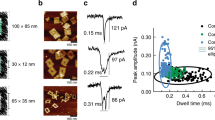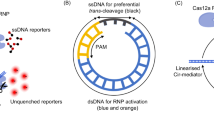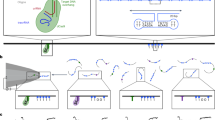Abstract
We report a protocol for the amplified detection of target DNA by using a chronocoulometric DNA sensor (CDS). Electrochemistry is known to be rapid, sensitive and cost-effective; it thus offers a promising approach for DNA detection. Our CDS protocol is based on a 'sandwich' detection strategy, involving a capture probe DNA immobilized on a gold electrode and a reporter probe DNA loaded on gold nanoparticles (AuNPs). Each probe flanks one of two fragments of the target sequence. A single DNA hybridization event brings AuNPs, along with hundreds of reporter probes, in the proximity of the electrode. We then employ chronocoulometry to interrogate [Ru(NH3)6]3+ electrostatically bound to the captured DNA strands. This AuNP-amplified DNA sensor can selectively detect as low as femtomolar (zeptomoles) concentrations of DNA targets and conveniently analyze a breast cancer-associated BRCA-1 mutant DNA. The time range for the entire protocol is ∼3 d, whereas the DNA sensing takes less than 2 h to complete.
This is a preview of subscription content, access via your institution
Access options
Subscribe to this journal
Receive 12 print issues and online access
$259.00 per year
only $21.58 per issue
Buy this article
- Purchase on Springer Link
- Instant access to full article PDF
Prices may be subject to local taxes which are calculated during checkout







Similar content being viewed by others
References
Staudt, L.M. Gene expression physiology and pathophysiology of the immune system. Trends Immunol. 22, 35–40 (2001).
Debouck, C. & Goodfellow, P.N. DNA microarrays in drug discovery and development. Nat. Genet. 21, 48–50 (1999).
Halford, W.P. The essential prerequisites for quantitative RT-PCR. Nat. Biotechnol. 17, 835 (1999).
Drummond, T.G., Hill, M.G. & Barton, J.K. Electrochemical DNA sensors. Nat. Biotechnol. 21, 1192–1199 (2003).
Fan, C., Plaxco, K.W. & Heeger, A.J. Biosensors based on binding-modulated donor–acceptor distances. Trends Biotechnol. 23, 186–192 (2005).
Millan, K.M., Saraullo, A. & Mikkelsen, S.R. Voltammetric DNA biosensor for cystic fibrosis based on a modified carbon paste electrode. Anal. Chem. 66, 2943–2948 (1994).
Yu, C.J. et al. Electronic detection of single-base mismatches in DNA with ferrocene-modified probes. J. Am. Chem. Soc. 123, 11155–11161 (2001).
Fan, C., Plaxco, K.W. & Heeger, A.J. Electrochemical interrogation of conformational changes as a reagentless method for the sequence-specific detection of picomolar DNA. Proc. Natl. Acad. Sci., USA 100, 9134–9137 (2003).
Patolsky, F., Lichtenstein, A. & Willner, I. Detection of single-base DNA mutations by enzyme-amplified electronic transduction. Nat. Biotechnol. 19, 253–257 (2001).
Park, S.J., Taton, T.A. & Mirkin, C.A. Array-based electrical detection of DNA with nanoparticle probes. Science 295, 1503–1506 (2002).
Hill, H.D. & Mirkin, C.A. The bio-barcode assay for the detection of protein and nucleic acid targets using DTT-induced ligand exchange. Nat. Protoc. 1, 324–336 (2006).
Steel, A.B., Herne, T.M. & Tarlov, M.J. Electrochemical quantitation of DNA immobilized on gold. Anal. Chem. 70, 4670–4677 (1998).
Ho, P.S., Frederick, C.A., Saal, D., Wang, A.H. & Rich, A. The interactions of ruthenium hexaammine with Z-DNA: crystal structure of a Ru(NH3)63+ salt of d(CGCGCG) at 1.2 Å resolution. J. Biomol. Struct. Dyn. 4, 521–534 (1987).
Lao, R. et al. Electrochemical interrogation of DNA monolayers on gold surfaces. Anal. Chem. 77, 6475–6480 (2005).
Kimura-Suda, H., Petrovykh, D.Y., Tarlov, M.J. & Whitman, L.J. Base-dependent competitive adsorption of single-stranded DNA on gold. J. Am. Chem. Soc. 125, 9014–9015 (2003).
Zhang, J. et al. Sequence-specific detection of femtomolar DNA via a chronocouloumetric DNA sensor (CDS): effects of nanoparticle-mediated amplification and nanoscale control of DNA assembly at electrodes. J. Am. Chem. Soc. 128, 8575–8580 (2006).
Acknowledgements
This work was supported by National Natural Science Foundation (60537030 and 20725516), Shanghai Municipal Commission for Science and Technology (0652nm006 and 0752nm021), National Basic Research Program of China (2006CB933000 and 2007CB936000), Shanghai Rising-Star Program and Chinese Academy of Sciences.
Author information
Authors and Affiliations
Corresponding author
Rights and permissions
About this article
Cite this article
Zhang, J., Song, S., Wang, L. et al. A gold nanoparticle-based chronocoulometric DNA sensor for amplified detection of DNA. Nat Protoc 2, 2888–2895 (2007). https://doi.org/10.1038/nprot.2007.419
Published:
Issue Date:
DOI: https://doi.org/10.1038/nprot.2007.419
This article is cited by
-
2D silicene nanosheets for the detection of DNA nucleobases for genetic biomarker: a DFT study
Structural Chemistry (2024)
-
Prospects and challenges of dynamic DNA nanostructures in biomedical applications
Bone Research (2022)
-
Recent advances in development of devices and probes for sensing and imaging in the brain
Science China Chemistry (2021)
-
Programming bulk enzyme heterojunctions for biosensor development with tetrahedral DNA framework
Nature Communications (2020)
-
Design, fabrication and applications of tetrahedral DNA nanostructure-based multifunctional complexes in drug delivery and biomedical treatment
Nature Protocols (2020)
Comments
By submitting a comment you agree to abide by our Terms and Community Guidelines. If you find something abusive or that does not comply with our terms or guidelines please flag it as inappropriate.



